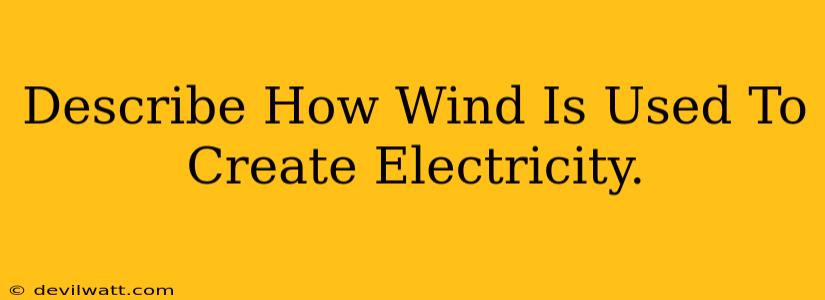Wind energy is a clean, renewable resource that's gaining popularity worldwide. But how exactly does the wind create electricity? This comprehensive guide will explore the mechanics behind wind energy generation, from the wind's kinetic energy to the power grid.
Understanding Wind Energy Basics
Wind energy harnesses the kinetic energy of moving air. This kinetic energy, the energy of motion, is converted into mechanical energy, and then into electrical energy through a series of ingenious processes. The key component is the wind turbine, a sophisticated machine designed to capture this energy efficiently.
The Components of a Wind Turbine
A typical wind turbine consists of several key parts:
-
Rotor: This is the most visible part – the large set of blades that rotate when wind blows. The design of these blades is crucial for optimizing energy capture. The shape and angle of the blades are carefully engineered to maximize the amount of wind energy converted into rotational force.
-
Nacelle: Housed at the top of the tower, the nacelle contains the gearbox, generator, and other critical components. It's the "brain" of the turbine. Here, the rotational energy from the rotor is transformed into electricity.
-
Gearbox: This crucial component increases the rotational speed of the low-speed shaft coming from the rotor. This higher speed is necessary for optimal generator performance.
-
Generator: This is where the magic happens. The generator uses the increased rotational speed to produce electricity through electromagnetic induction. As a magnet spins within a coil of wire, it generates an electric current.
-
Tower: This supports the entire turbine structure, elevating the rotor blades to capture stronger, more consistent winds at higher altitudes. Tower height is a critical design factor.
The Process of Electricity Generation
-
Wind Power: Wind blowing across the rotor blades creates lift and drag. This forces the blades to rotate.
-
Mechanical Energy: The rotating blades turn the low-speed shaft inside the nacelle.
-
Gearbox Amplification: The gearbox increases the rotational speed of the shaft, making the generator more efficient.
-
Electrical Energy: The high-speed shaft spins the generator, creating electricity through electromagnetic induction.
-
Power Transmission: The generated electricity travels through cables down the tower and into the electrical grid, powering homes and businesses.
Advantages of Wind Energy
-
Renewable: Wind is a virtually inexhaustible resource.
-
Clean: Wind energy produces no greenhouse gas emissions during operation, contributing to a cleaner environment.
-
Sustainable: It’s a sustainable energy source that helps reduce our reliance on fossil fuels.
-
Cost-effective: The cost of wind energy has decreased significantly, making it a competitive energy source.
Challenges of Wind Energy
-
Intermittency: Wind availability varies, meaning electricity generation is not always constant. This requires effective energy storage solutions or integration with other power sources.
-
Environmental Impacts: Some environmental concerns include noise pollution, impact on wildlife (birds and bats), and visual impact on landscapes. Careful site selection and turbine design can mitigate these effects.
-
Land Use: Wind farms require significant land area, potentially impacting agricultural land or natural habitats.
-
Transmission Infrastructure: Efficient transmission infrastructure is needed to transport the electricity generated from wind farms to populated areas.
The Future of Wind Energy
Wind energy is playing an increasingly important role in the global transition to clean energy. Technological advancements are continuously improving the efficiency and cost-effectiveness of wind turbines, making them even more attractive as a sustainable energy source. Further advancements in energy storage and grid management will help to address the intermittency challenges and unlock the full potential of wind power. The future looks bright for wind energy, promising a cleaner and more sustainable future for generations to come.

